Caribbean-Wide, Negative Emissions Solution to Sargassum spp. Low-Cost Collection Device and Sustainable Disposal Method
Abstract
:1. Introduction
1.1. Design Overview
1.2. Pilot Tests
2. Materials and Methods
2.1. System Sizing and Costing
2.2. Carbon Accounting
Process Emissions
3. Results
3.1. System Sizing and Costing
3.2. Carbon Accounting
3.2.1. Process Emissions
3.2.2. Negative Emissions Potential
4. Discussion
4.1. SOS Carbon Credits
4.2. Offshore SOS Carbon Fleet
4.3. Environmental Impact
5. Conclusions
- LCMs can increase Sargassum collection by lowering costs and extending technology accessibility beyond tourist locations;
- LCM + Towline + SOS Carbon Barge system provides a sustainable, high-capacity, inconspicuous means of Sargassum disposal for the increasing volumes of collected Sargassum that cannot be 100% valorized;
- LCM + Towline + SOS Carbon Barge system has the potential to offset up to 1.356 → 3.029 tCO2e/dmt Sargassum (less process emissions), but additionality must be considered further;
- LCM + Towline system provides a low-cost alternative to the SOS Carbon barge, but non-permanence of emissions reductions must be considered further and local oceanographic context must be carefully considered and processes conducted responsibly so as to not cause increased landfall in neighboring beaches;
- SOS Carbon pilot test provided full-scale pump-to-depth hardware validation and the SOS Carbon system could one day be deployed on a fleet of ocean-going vessels.
6. Patents
Supplementary Materials
Author Contributions
Funding
Institutional Review Board Statement
Informed Consent Statement
Data Availability Statement
Acknowledgments
Conflicts of Interest
Appendix A
Appendix B
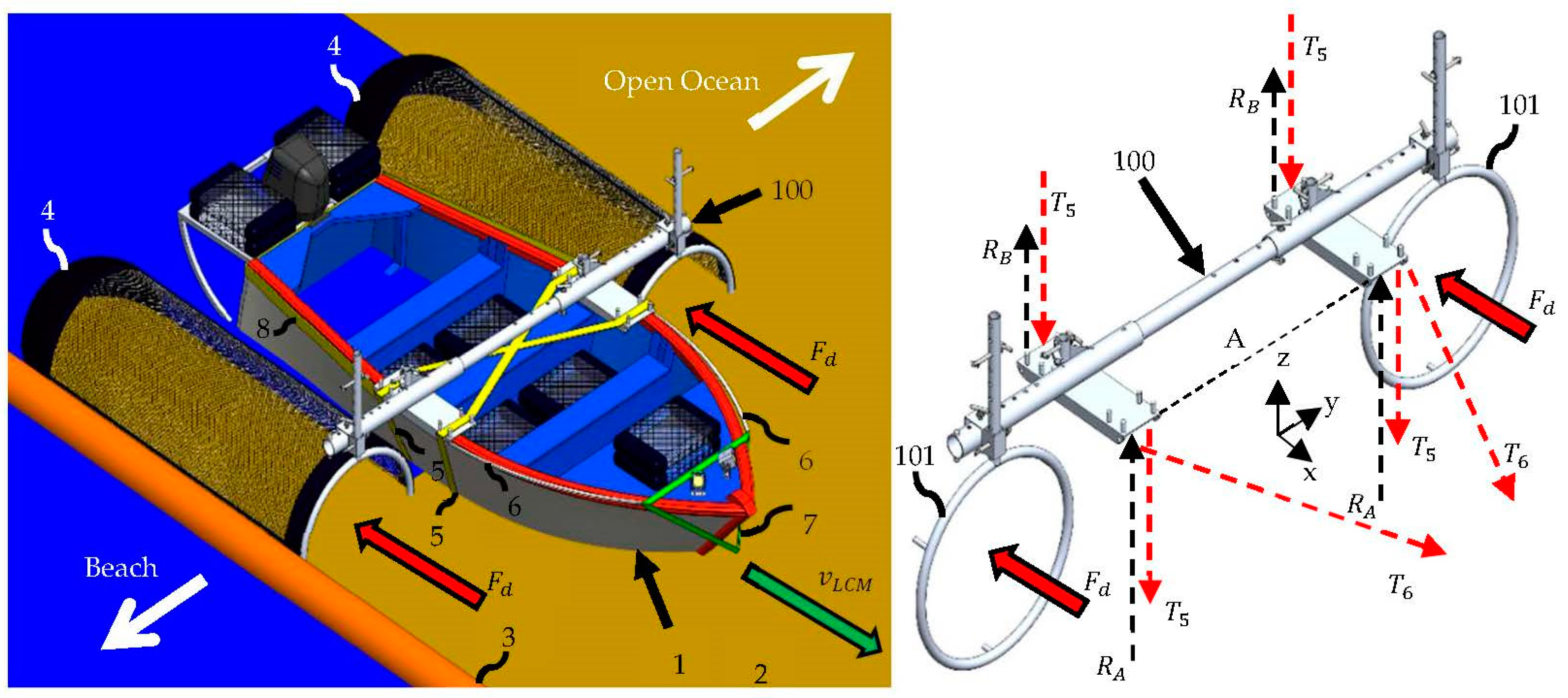
Appendix C

References
- Franks, S.J.; Johnson, R.D.; Ko, S.D.; Sanchez-Rubio, G.; Hendon, R.J.; Lay, M. Unprecedented influx of pelagic Sargassum along Caribbean island coastlines during summer 2011. Proc. Gulf Caribb. Fish. Inst. 2011, 64, 6. [Google Scholar]
- Gower, J.; Young, E.; King, S. Satellite images suggest a new Sargassum source region in 2011. Remote. Sens. Lett. 2013, 4, 764–773. [Google Scholar] [CrossRef]
- Johnson, D.R.; Ko, D.S.; Franks, J.S.; Moreno, P.; Sanchez-Rubio, G. The Sargassum invasion of the Eastern Caribbean and Dynamics of the Equatorial North Atlantic. Proc. Gulf Caribb. Fish. Inst. 2012, 65, 102. [Google Scholar]
- Wang, M.; Hu, C. Mapping and quantifying Sargassum distribution and coverage in the Central West Atlantic using MODIS observations. Remote. Sens. Environ. 2016, 183, 350–367. [Google Scholar] [CrossRef]
- Putman, N.F.; Goni, G.J.; Gramer, L.J.; Hu, C.; Johns, E.M.; Trinanes, J.; Wang, M. Simulating transport pathways of pelagic Sargassum from the Equatorial Atlantic into the Caribbean Sea. Prog. Oceanogr. 2018, 165, 205–214. [Google Scholar] [CrossRef]
- de Széchy, M.T.M.; Guedes, P.M.; Baeta-Neves, M.H.; Oliveira, E.N. Verification of Sargassum natans (Linnaeus) Gaillon (Heterokontophyta: Phaeophyceae) from the Sargasso Sea off the coast of Brazil, western Atlantic Ocean. Check List 2012, 8, 638–641. [Google Scholar] [CrossRef] [Green Version]
- Wang, M.; Hu, C.; Barnes, B.B.; Mitchum, G.; Lapointe, B.; Montoya, J.P. The great Atlantic Sargassum belt. Science 2019, 365, 83–87. [Google Scholar] [CrossRef] [PubMed]
- Oviatt, C.A.; Huizenga, K.; Rogers, C.S.; Miller, W.J. What nutrient sources support anomalous growth and the recent Sargassum mass stranding on Caribbean beaches? A Rev. Mar. Pollut. Bull. 2019, 145, 517–525. [Google Scholar] [CrossRef] [PubMed]
- Innovative system to control the arrival of Sargassum to the coasts of Quintana Roo. The Yucatan Times, 12 October 2018.
- Milledge, J.J.; Maneein, S.; Lopez, E.A.; Bartlett, D. Sargassum inundations in Turks and Caicos: Methane potential and proximate, ultimate, lipid, amino acid, metal and metalloid analyses. Energies 2020, 13, 1523. [Google Scholar] [CrossRef] [Green Version]
- World Travel & Tourism Council. Caribbean Resilience and Recovery: Minimising the Impact of the 2017 Hurricane Season on the Caribbean’s Tourism Sector; World Travel & Tourism Council: London, UK, 2017. [Google Scholar]
- World Travel & Tourism Council. Economic Impact Reports; World Travel & Tourism Council: London, UK, 2020. [Google Scholar]
- Resiere, D.; Valentino, R.; Neviere, R.; Banydeen, R.; Gueye, P.; Florentin, J. Sargassum seaweed on Caribbean islands: An international public health concern. Lancet 2018, 392, 2691. [Google Scholar] [CrossRef] [Green Version]
- Zanolli, L. Why Seaweed Is Strangling Mexican Tourism, and How Science Could Help; MIT Technology Review: Cambridge, MA, USA, 2019. [Google Scholar]
- Tourism down 30-35% due to Sargassum: Playa del Carmen mayor-elect. Mexico Daily News, 4 August 2018.
- Government predicts 30% drop in tourism due to Sargassum invasion. Mexico Daily News, 9 May 2019.
- Jessop, D. Sargassum a Continuing Challenge for Tourism; The Caribbean Council: London, UK, 2019. [Google Scholar]
- Sargassum a potential natural disaster for Caribbean beaches: Researchers. Mexico Daily News, 3 August 2018.
- CARICOM. Millions of Dollars, Massive Manpower Needed to Tackled Sargassum Seaweed; CARICOM: Georgetown, Guyana, 2015. [Google Scholar]
- Milledge, J.J.; Harvey, P.J. Golden tides: Problem or golden opportunity? The valorisation of Sargassum from beach inundations. J. Mar. Sci. Eng. 2016, 4, 60. [Google Scholar] [CrossRef]
- Rodríguez-Martínez, R.E.; Roy, P.D.; Torrescano-Valle, N.; Cabanillas-Terán, N.; Carrillo-Domínguez, S.; Collado-Vides, L.; García-Sánchez, M.; van Tussenbroek, B.I. Element concentrations in pelagic Sargassum along the Mexican Caribbean coast in 2018–2019. PeerJ 2020, 8, e8667. [Google Scholar] [CrossRef] [Green Version]
- Slocum, A.H. Symbiotic offshore energy harvesting and storage systems. Sustain. Energy Technol. Assess. 2015, 11, 135–141. [Google Scholar] [CrossRef]
- Peng, V.; Slocum, A.H. Endemic water and storm trash to energy via In Situ processing. Renew. Sustain. Energy Rev. 2020, 134, 110272. [Google Scholar] [CrossRef]
- Johnson, D.L.; Richardson, P.L. On the wind-induced sinking of Sargassum. J. Exp. Mar. Biol. Ecol. 1977, 28, 255–267. [Google Scholar] [CrossRef]
- Gray, L.A. Sequestering Floating Biomass in the Deep Ocean: “Sargassum Ocean Sequestration of Carbon” (SOS Carbon). Master’s Thesis, Massachusetts Institute of Technology, Cambridge, MA, USA, March 2020. [Google Scholar]
- SOS Carbon, S.R.L. Available online: https://soscarbon.com/ (accessed on 8 August 2021).
- “Fuel energy density.” IOR Energy. Available online: https://web.archive.org/web/20100825042309/http://www.ior.com.au/ecflist.html (accessed on 8 August 2020).
- United States Naval Academy (USNA). EN400: Principles of Ship Performance, Chapter 7: Resistance and Powering of Ships; United States Naval Academy (USNA): Annapolis, MD, USA, 2020. [Google Scholar]
- “Godwin DPC300.” Xylem Inc. Available online: https://www.xylem.com/en-us/products-services/pumps-packaged-pump-systems/pumps/self-priming-pumps/automatic-self-priming-pumps/dri-prime/cd-series/godwin-dpc300 (accessed on 8 August 2020).
- Cengel, Y.A.; Cimbala, J.M. Fluid Mechanics: Fundamentals and Applications. McGraw-Hill Series in Mechanical Engineering, Chapter 11-5. 582; McGraw-Hill: New York, NY, USA, 2006. [Google Scholar]
- Lomas, M.W.; Bates, N.R.; Buck, K.N.; Knap, A.H. Notes on “Microbial productivity of the Sargasso Sea and how it compares to elsewhere”, and “The Role of the Sargasso Sea in carbon sequestration–Better than carbon neutral?”. Sargasso Sea Alliance Sci. Rep. Ser. 2011, 6, 10. [Google Scholar]
- Allan, W.S. Pelagic Sargassum: Evidence for major decrease in biomass. Deep. Sea Res. 1983, 30, 469–474. [Google Scholar]
- Bauer, J.E.; Williams, P.M.; Druffel, E.R.M. 14C activity of dissolved organic carbon fractions in the north-central Pacific and Sargasso Sea. Nature 1992, 357, 667–670. [Google Scholar] [CrossRef]
- Itoh, H.; Aoki, M.N.; Tsuchiya, Y.; Sato, T. Fate of organic matter in faecal pellets egested by epifaunal mesograzers in a Sargassum forest and implications for biogeochemical cycling. Mar. Ecol. Prog. Ser. 2007, 352, 101–112. [Google Scholar] [CrossRef] [Green Version]
- Laffoley, D.; Baxter, J.M.; Thevenon, F.; Oliver, J. The Significance and Management of Natural Carbon Stores in the Open Ocean; Full Report; IUCN: Switzerland, Gland, 2014; p. 124. [Google Scholar]
- Intergovernmental Panel on Climate Change (IPCC). National Guideline for National Greenhouse Gas Inventories: Volume 5-Solid Waste Disposal; Technical Report; Intergovernmental Panel on Climate Change (IPCC): Geneva, Switzerland, 2006. [Google Scholar]
- Myhre, G.; Shindell, D.; Breon, F.-M.; Collins, W.; Fuglestvedt, J.; Huang, J.; Koch, D.; Lamarque, J.-F.; Lee, D.; Mendoza, B.; et al. 2013: Anthropogenic and natural radiative forcing. In Climate Change 2013: The Physical Science Basis. Contribution of Working Group I to the Fifth Assessment Report of the Intergovernmental Panel on Climate Change, Chapter 8; Stocker, T.F., Qin, D., Plattner, G.-K., Tignor, M., Allen, S.K., Boschung, J., Nauels, A., Xia, Y., Bex, V., Midgley, P.M., Eds.; Cambridge University Press: Cambridge, UK; New York, NY, USA, 2013. [Google Scholar]
- U.S. Environmental Protection Agency (EPA). Greenhouse Gas Inventory Guidance: Direct Emissions from Stationary Combustion Sources; U.S. Environmental Protection Agency (EPA): Washington, DC, USA, 2016.
- Register, F. Light-duty vehicle greenhouse gas emission standards and corporate average fuel economy standards; final rule. Fed. Regist. 2010, 75, 25330. [Google Scholar]
- “PT Royal Lestari Utama.” Tropical Landscapes Finance Facility (TLFF). Available online: http://tlffindonesia.org/project-pt-royal-lestari-utama/ (accessed on 8 August 2020).
- Fuss, S.; Lamb, W.F.; Callaghan, M.W.; Hilaire, J.; Creutzig, F.; Amann, T.; Beringer, T.; de Oliveira Garcia, W.; Hartmann, J.; Khanna, T.; et al. Negative emissions-Part 2: Costs, potentials, and side effects. Environ. Res. Lett. 2018, 13, 063002. [Google Scholar] [CrossRef] [Green Version]
- Hu, C.; Murch, B.; Barnes, B.B.; Wang, M.; Marechal, J.; Franks, J.; Johnson, D.; Lapointe, B.; Goodwin, D.S.; Schell, J.M.; et al. Sargassum watch warns of incoming seaweed. Eos 2016, 97, 10–15. [Google Scholar] [CrossRef] [Green Version]
- Wang, M.; Hu, C. Predicting Sargassum blooms in the Caribbean Sea from MODIS observations. Geophys. Res. Letters. 2017, 44, 3265–3273. [Google Scholar] [CrossRef]
- “SAMtool.” CLS. Available online: https://datastore.cls.fr/products/Sargassum/ (accessed on 8 August 2020).
- Lett, C.; Verley, P.; Mullon, C.; Parada, C.; Brochier, T.; Penven, P.; Blanke, B. A Lagrangian tool for modelling ichthyoplankton dynamics. Environ. Model. Softw. 2008, 23, 1210–1214. [Google Scholar] [CrossRef] [Green Version]
- Schoener, A.; Rowe, G.T. Pelagic Sargassum and its presence among the deep-sea benthos. Deep Sea Res. 1970, 17, 923–925. [Google Scholar] [CrossRef]
- Fleury, A.; Drazen, J.C. Abyssal Scavenging Communities attracted to Sargassum and fish in the Sargasso Sea. Deep Sea Res. Part I Oceanogr. Res. Pap. 2013, 72, 141–147. [Google Scholar] [CrossRef]
- Lawson, G.S.; Tyler, P.A.; Young, C.M. Attraction of deep-sea amphipods to macrophyte food falls. J. Exp. Mar. Biol. Ecol. 1993, 169, 33–39. [Google Scholar] [CrossRef]
- Harrold, C.; Light, K.; Lisin, S. Organic enrichment of submarine-canyon and continental-shelf benthic communities by macroalgal drift imported from nearshore kelp forests. Am. Soc. Limnol. Oceanogr. 1998, 43, 669–678. [Google Scholar] [CrossRef]
- EU Emissions Trading System (EU ETS). European Union (EU). Available online: https://ec.europa.eu/clima/policies/ets_en (accessed on 8 August 2020).
- Carbon Offsetting and Reduction Scheme for International Aviation (CORSIA). International Civil Aviation Organization (ICAO). Available online: https://www.icao.int/environmental-protection/CORSIA/Pages/default.aspx (accessed on 8 August 2020).
- Caribbean Leaders Discuss Debt for Climate Adaptation Swap, Caribbean Resilience Fund. IISD SDG Knowledge Hub. Available online: https://sdg.iisd.org/news/caribbean-leaders-discuss-debt-for-climate-adaptation-swap-caribbean-resilience-fund/#:~:text=The%20’Debt%20for%20Climate%20Adaptation,region’s%20high%20level%20of%20debt.&text=According%20to%20ECLAC%2C%20the%20Caribbean,climate%2Drelated%20disasters%20since%201990 (accessed on 8 August 2020).
- 3 Steps to Ensure the COVID-19 Economic Crisis Does Not Harm Climate Adaptation Plans. Global Center on Adaption, July 8, 2020. Available online: https://gca.org/solutions/3-steps-to-ensure-the-covid-19-economic-crisis-does-not-harm-climate-adaptation-plans (accessed on 8 August 2020).
- Report of the World Commission on Environment and Development: Our Common Future. World Commission on Environment and Development. Available online: https://sustainabledevelopment.un.org/milestones/wced (accessed on 8 August 2020).
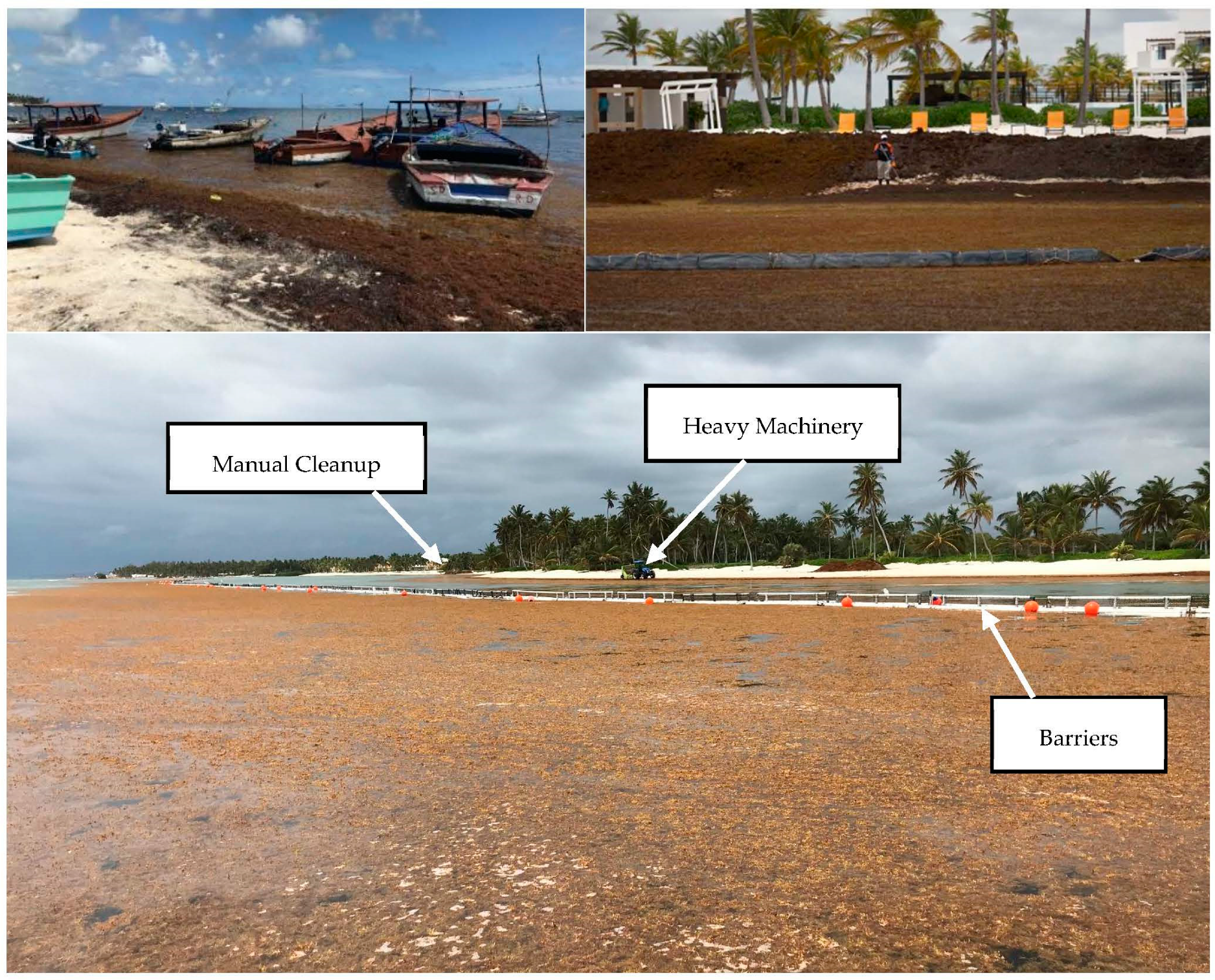
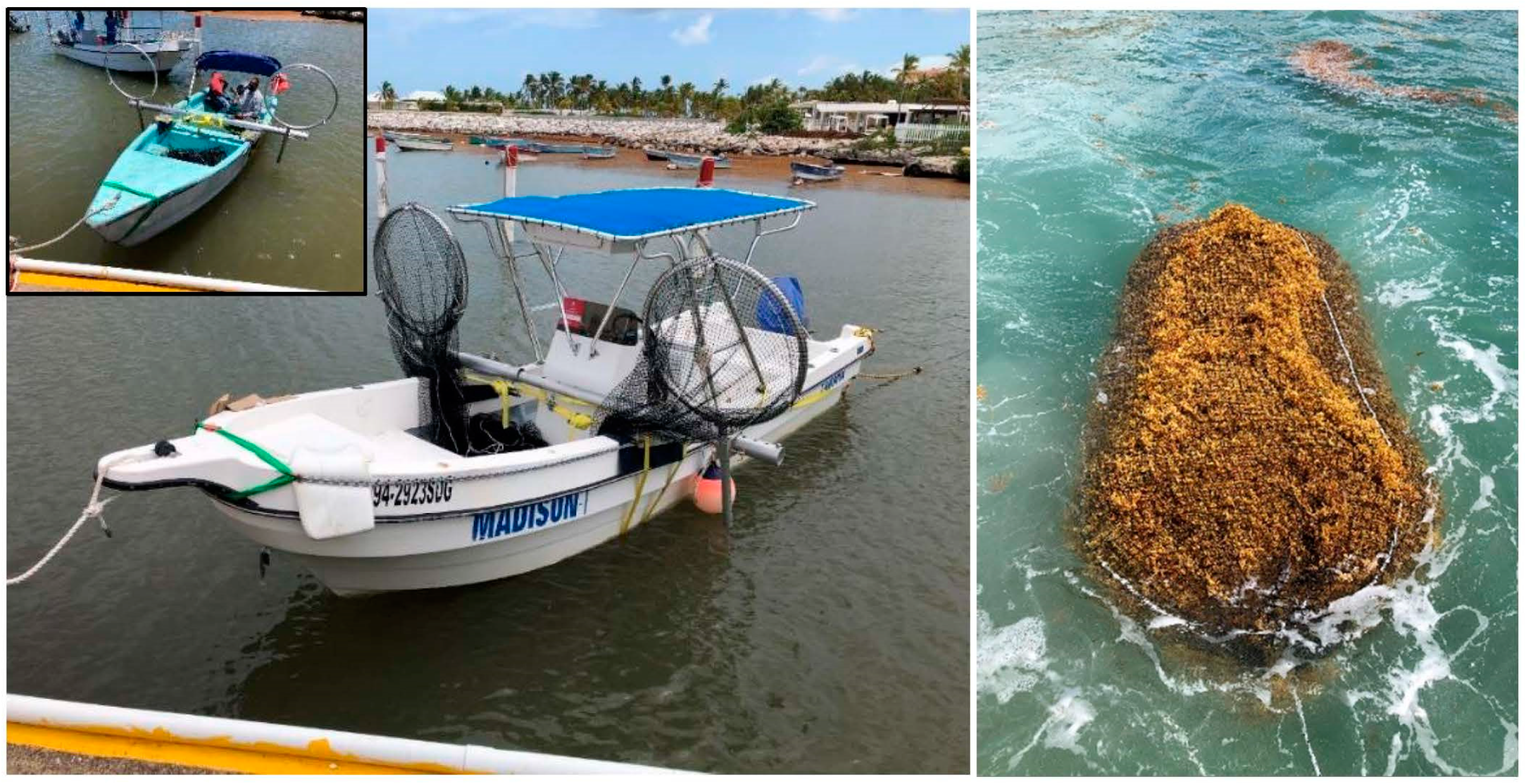

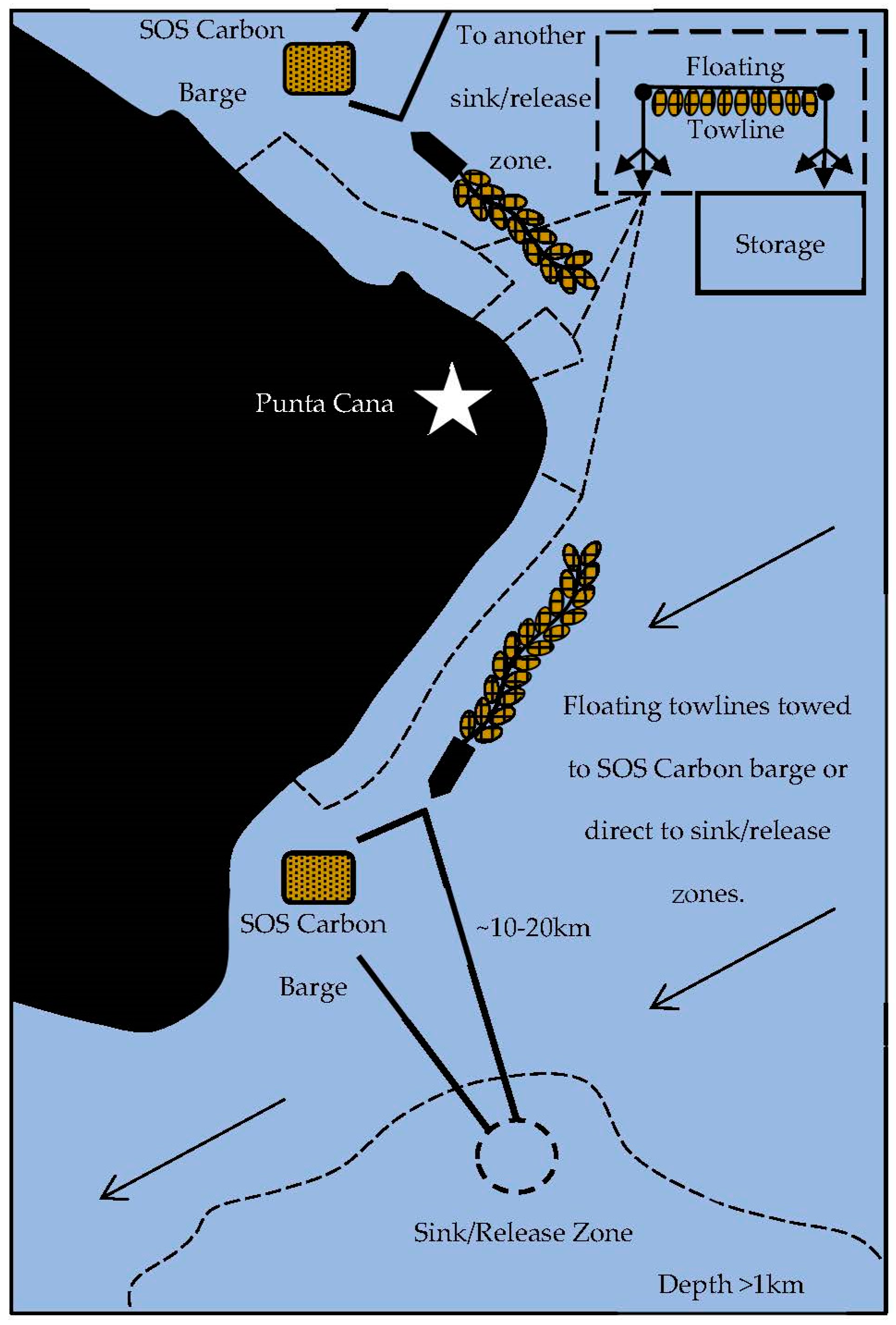


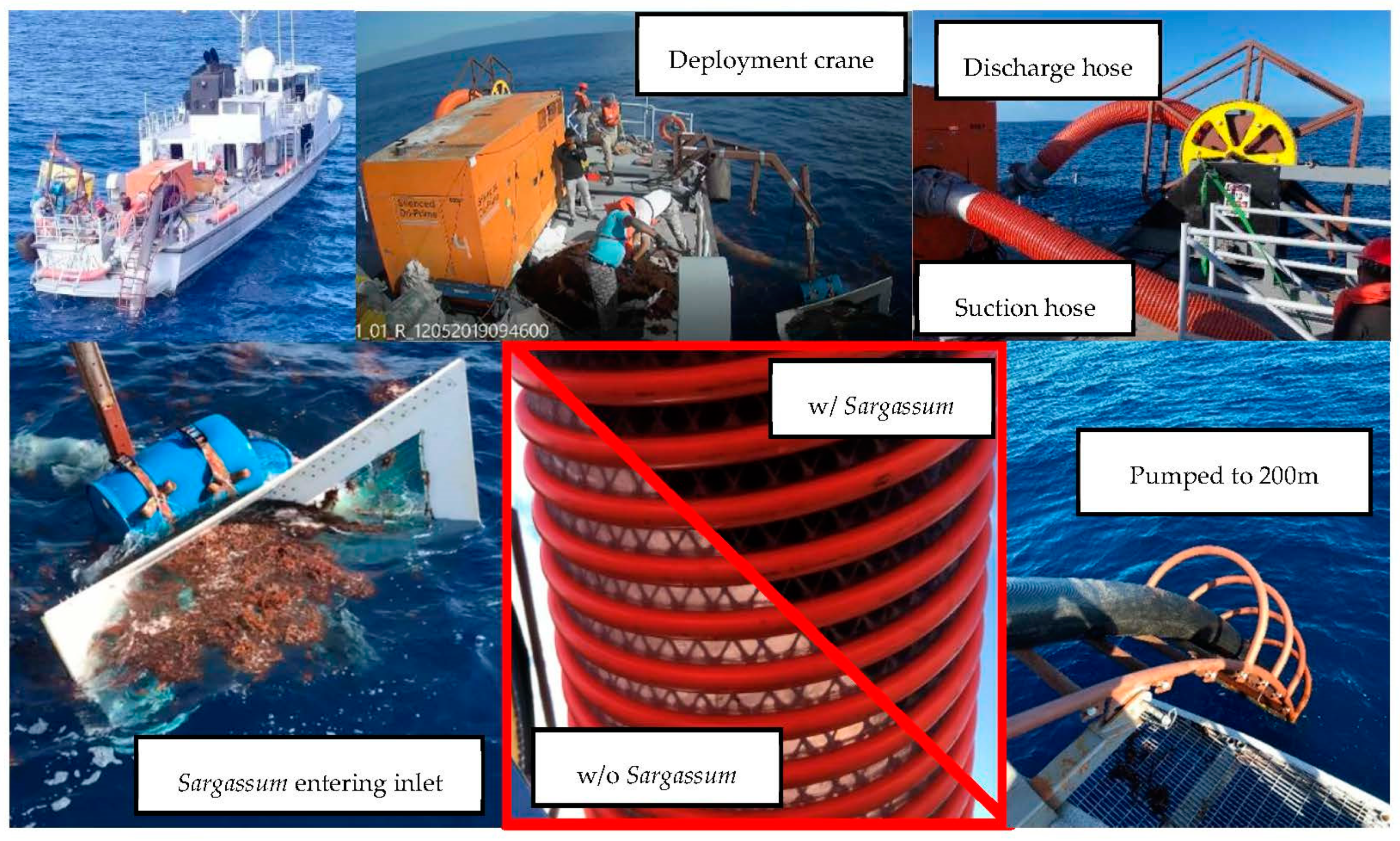


| Process | Benefits |
|---|---|
| LCM Collection | LOW CAPITAL—LCMs can be deployed by the tourism industry, national or local governments, and even civilians wanting to protect their local coastline. When not in use, boats can be used for normal functions and there is no capital tied up in expensive, dedicated machinery. |
| LOW LEAD-TIME—LCM fabrication takes days at most versus months for large conveyor-based harvesters. LCMs can be mass-manufactured and repaired anywhere in the world using only a hand drill, cutting wheel, pipe roller, welder, common extruded aluminum shapes, and off-the-shelf rigging accessories. | |
| LOW MARGINAL-COST—Flattened cost curve enables operation continuously all day, even for small amounts of Sargassum, compared with large conveyor-based harvesters that can only be taken out when significant amounts of Sargassum accumulate, by which time Sargassum will have passed under/through barriers and landed on beaches. | |
| HIGH-CAPACITY—At 300 m3/LCM/day collection capacity, just 2–3 LCMs match the instantaneous collection rate of large conveyor-based harvesters, and, unlike large conveyor-based harvesters, LCMs can operate all day, due to a low marginal-cost and freedom from daily start-up, maintenance, and washdown procedures. The average Sargassum collection rate per LCM-operator is up to 10× the rate of an individual performing onshore, manual raking. | |
| VERSATILE—Mobility of small LCM boats enables fast response time and coverage of large areas. LCMs can collect from barriers, marinas, offshore, and up-river. Shallow draft of LCM boats even enables collecting from the intertidal zone (where Sargassum has already landed) or behind barriers (collecting only Sargassum that leaks through barriers, thereby increasing cost-effectiveness) and may thereby obviate the need for barriers altogether (large conveyor-based harvesters require barriers to keep Sargassum in deeper water). | |
| INCONSPICUOUS—Repurposed LCM boats are already part of the local scenery, compared with large, noisy, special machinery used today. | |
| WORKER-FRIENDLY—LCMs eliminate occupational hazards related to manual shoveling of Sargassum amidst toxic fumes. LCMs are engineered for maximum operator safety (see Appendix B). | |
| LOW-IMPACT—Less risk of damaging critical habitat and infrastructure (e.g., barriers, reefs, and seagrasses) compared to heavy machinery (e.g., trucks, conveyor-based harvesters, and excavators) used currently. LCMs avoid bycatch via up-close visual monitoring. Sargassum nets are transported to access points through water, not over land. | |
| SAND-FREE—Manual collection from beaches yields sand-laden Sargassum, which is hard to process (e.g., compost and anaerobic digestion). LCMs enable collection of Sargassum from water, without any sand. The LCM may therefore be key to the success of Sargassum valorization efforts and many local entrepreneurs starting these small businesses. | |
| SOS Carbon Disposal (and Towline) | HIGH-CAPACITY—Able to dispose of large amounts of Sargassum without limits of market building and supply chains logistics imposed by Sargassum valorization products. MOBILE—Able to easily relocate depending on Sargassum geographic distribution. INCONSPICUOUS—Sargassum transported and disposed via water rather than carried/trucked through resort areas and dumped in nearby landfills. NEGATIVE EMISSIONS—Avoiding landfilling and coastal methanogenesis reduces greenhouse gas emissions. NO PUBLIC HEALTH RISK—No particulate or toxic fumes (hydrogen sulfide) and no risk of toxicity leaching into groundwater. |
| Parameter | Value | Symbol | Ref./Explain |
|---|---|---|---|
| Avg. kilometric Sargassum influx (m3/km/day) | 250 | 500+ hours operation | |
| LCM net diameter (m) | 1 | ||
| LCM net length (m) | 3 | ||
| LCM net compaction multiplier | 2 | ||
| Full LCM net roughness (m) | 0.025 | ||
| Length of working day (h/day) | 10 | ||
| Productive percent of day spent collecting (%) | 50% | PP | 500+ hours operation |
| LCM net collection rate (nets/h) | 2030 | 500+ hours operation | |
| Avg. dist. from collection area to towline (km) | 0.125 | 2 towlines per km | |
| Average dist. from towline to barge (km) | 3 | 1 barge per 12 km | |
| Nets LCM can tow at once (nets) | 4 | 500+ hours operation | |
| LCM towing speed (kph) | 3 | ~1.6 knots | |
| LCM transit speed (kph) | 10 | ~5.4 knots | |
| LCM personnel (people/LCM) | 3 | 1 capt. + 2 net handlers | |
| All personnel wage ($/person/month) | $250 | >min. wage in DR | |
| LCM Ins. + Maint. and Rep. ($/LCM/month) | $300 | w/3 people per LCM | |
| Cost of diesel fuel ($/L) | $0.85 | Can vary across Caribbean | |
| Energy density of diesel fuel (MJ/L) | 38.6 | [27] | |
| Cost of gasoline ($/L) | $1.25 | Can vary across Caribbean | |
| LCM fuel consumption (L/h) | 7.5 | 500+ hours operation | |
| Towline tow vessel brake horsepower (kW) | 750 | Assuming small utility boat | |
| Length of towline towing vessel (m) | 30 | Assuming small utility boat | |
| Beam of towline towing vessel (m) | 10 | Assuming small utility boat | |
| Draught of towline towing vessel (m) | 3 | Assuming small utility boat | |
| Minimum towline towing velocity (m/s) | 3 | To empty Sargassum nets | |
| Nets attached per meter on towline (nets/m) | 2 | Ea. attach. pt. takes 2 nets | |
| Towline tow vessel personnel (people/boat) | 4 | ||
| Tow vessel Ins. + Maint. and Rep. ($/boat/month) | $1.5 k | ||
| Binwall barge length (m) | 75 | Listed from marine broker | |
| Binwall barge beam (m) | 20 | Listed from marine broker | |
| Binwall barge draught (m) | 4 | Listed from marine broker | |
| Barge towing velocity (m/s) | 4 | ~8 knots | |
| SOS Carbon barge grain capacity (m3) | 3000 | ||
| SOS Carbon barge compaction multiplier | 2 | ||
| SOS Carbon barge personnel (people/barge) | 5 | ||
| Ins. + Maint. and Rep. ($/barge/month) | $10 k | ||
| Wave making resist. as % of viscous resist. (%) | 100% | WMR | USNA [28] |
| Engine efficiency (%) | 24% | e.g., Cummins KTA38 | |
| Gear reduction efficiency (%) | 95% | USNA [28] | |
| Propulsive efficiency (%) | 55% | USNA [28] | |
| Dist. to sink/release zone (km) | 15 | 10–20 km | |
| SOS Carbon barge pump capacity (m3/s) | 0.63 | 2 pair 2 ea 5000 GPM pumps | |
| SOS Carbon pump solids concentration (%) | 33% | SOS Carbon pilot [25] | |
| Pump fuel consumption (L/h) | 8 | Godwin DPC300 [29] | |
| Loose-pack Sargassum density (kg/m3) | 40 | Wet | |
| Avg. dry weight as percent of wet weight (%) | 13.27% | Species average from [10] | |
| Density seawater @ STP and st. salinity (kg/m3) | 1023 | ||
| Kinematic viscosity seawater @ 15 °C (m2/s) | 1.188e-6 | ||
| Barge cost ($) | $1 MM | Conservative | |
| Towline cost ($) | $3 k | Conservative | |
| Pump cost ($) | $150 k | Godwin DPC300 [29] | |
| Cost of LCM ($/LCM) | $2000 | Prototypes w/U.S. labor | |
| Cost of nets ($/net) | $30 | Prototypes w/U.S. labor |
| Parameter | Value | Symbol | Ref./Explain. |
|---|---|---|---|
| S. natans I dry weight percent of wet weight | 12.60% | J. J. Milledge 2020 [10] | |
| S. natans VIII dry weight percent of wet weight | 13.50% | J. J. Milledge 2020 [10] | |
| S. fluitans dry weight percent of wet weight | 13.70% | J. J. Milledge 2020 [10] | |
| S. natans I %VS of wet weight | 8.10% | J. J. Milledge 2020 [10] | |
| S. natans I degradable organic carbon | 64.3% | %VS of dry wt. | |
| S. natans I decomposable fraction of DOC | 17% | Biodegradability [10] | |
| S. natans VIII %VS of wet weight | 8.91% | J. J. Milledge 2020 [10] | |
| S. natans VIII degradable organic carbon | 66.0% | %VS of dry wt. | |
| S. natans VIII decomposable fraction of DOC | 37% | Biodegradability [10] | |
| S. fluitans %VS of wet weight | 9.08% | J. J. Milledge 2020 [10] | |
| S. fluitans degradable organic carbon | 66.3% | %VS of dry wt. | |
| S. fluitans decomposable fraction of DOC | 29% | Biodegradability [10] | |
| Methane correction factor | 0.6 | IPCC (2006) [36] | |
| Methane vol. fraction of generated landfill gas | 0.5 | IPCC (2006) [36] | |
| GWP100 of CH4 [kgCO2e g−1 CH4] | 28 | [37] | |
| S. natans I theoretical pot. [mL CH4 g−1 VS] | 392 | J. J. Milledge 2020 [10] | |
| S. natans VIII theoretical pot. [mL CH4 g−1 VS] | 395 | J. J. Milledge 2020 [10] | |
| S. fluitans theoretical pot. [mL CH4 g−1 VS] | 392 | J. J. Milledge 2020 [10] | |
| S. natans I measured pot. [mL CH4 g−1 VS] | 65.8 | J. J. Milledge 2020 [10] | |
| S. natans VIII measured pot. [mL CH4 g−1 VS] | 145.1 | J. J. Milledge 2020 [10] | |
| S. fluitans measured pot. [mL CH4 g−1 VS] | 112.7 | J. J. Milledge 2020 [10] | |
| Methane density @ STP (kg/m3) | 0.657 | ||
| Carbon dioxide density at STP (kg/m3) | 1.98 |
| LCM + Towline | LCM + Towline + Barge | |
|---|---|---|
| Collection + Storage ($/dmt) | $43.94 | $43.94 |
| Transportation to Sink/Release Zone ($/dmt) | $55.22 | $63.55 |
| Pump-to-depth ($/dmt) | n/a | $6.84 |
| Total Tonnage Cost ($/dmt) | $99.16 | $114.33 |
| Total Volumetric Cost ($/m3) | $0.53 | $0.61 |
| Average daily kilometric cost ($/km/day) | $131.59 * | $151.71 * |
| Landfill Emissions Potential (kgCO2e/dmt) | |||
|---|---|---|---|
| S. natans I | S. natans VIII | S. fluitans | |
| 1356 | 3029 | 2384 | |
| 5135 | 5312 | 5294 | |
| 862 | 1951 | 1522 | |
| LCM + Towline | LCM + Towline + Barge | |
|---|---|---|
| Collection + Storage (kgCO2/dmt) | 33 | 33 |
| Transportation to Sink/Release Zone (kgCO2/dmt) | 163 | 110 |
| Pump-to-depth (kgCO2/dmt) | n/a | 22 |
| Total process emissions (kgCO2/dmt) | 196 | 165 |
Publisher’s Note: MDPI stays neutral with regard to jurisdictional claims in published maps and institutional affiliations. |
© 2021 by the authors. Licensee MDPI, Basel, Switzerland. This article is an open access article distributed under the terms and conditions of the Creative Commons Attribution (CC BY) license (https://creativecommons.org/licenses/by/4.0/).
Share and Cite
Gray, L.A.; Bisonó León, A.G.; Rojas, F.E.; Veroneau, S.S.; Slocum, A.H. Caribbean-Wide, Negative Emissions Solution to Sargassum spp. Low-Cost Collection Device and Sustainable Disposal Method. Phycology 2021, 1, 49-75. https://doi.org/10.3390/phycology1010004
Gray LA, Bisonó León AG, Rojas FE, Veroneau SS, Slocum AH. Caribbean-Wide, Negative Emissions Solution to Sargassum spp. Low-Cost Collection Device and Sustainable Disposal Method. Phycology. 2021; 1(1):49-75. https://doi.org/10.3390/phycology1010004
Chicago/Turabian StyleGray, Luke A., Andres G. Bisonó León, Folkers E. Rojas, Samuel S. Veroneau, and Alexander H. Slocum. 2021. "Caribbean-Wide, Negative Emissions Solution to Sargassum spp. Low-Cost Collection Device and Sustainable Disposal Method" Phycology 1, no. 1: 49-75. https://doi.org/10.3390/phycology1010004
APA StyleGray, L. A., Bisonó León, A. G., Rojas, F. E., Veroneau, S. S., & Slocum, A. H. (2021). Caribbean-Wide, Negative Emissions Solution to Sargassum spp. Low-Cost Collection Device and Sustainable Disposal Method. Phycology, 1(1), 49-75. https://doi.org/10.3390/phycology1010004







